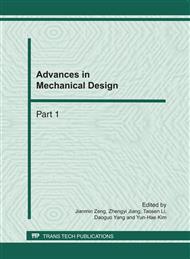[1]
Xiu Huijuan, Li Jinbao. Slime Forming Mechanism and Eliminating Method. Southwest Pulp and Paper. 2004, 3, 48-49.
Google Scholar
[2]
Xie Laisu, Biotechnology of Pulp and Papermaking. Beijing: Chemical Industry Publishing House, (2003).
Google Scholar
[3]
Wang Xiongbo, Prevention and Cure of Slime Trouble. Chian Pulp & Paper Industry, 2000, 3, 42-45.
Google Scholar
[4]
FujitaY, AwajiH, TanedaH, et a. l RecentAdvances in Enzymatic Pitch Control[J]. Tappi J., 1992, 75(4): 117.
Google Scholar
[5]
Van TilbeurghH, EgloffM P, MartinezC, et a. l Interfacial activa-tion of the lipase-procolipase complex bymixed micelis revealed by X-raycrystal lography[J]. Nature, 1993, 362: 814.
Google Scholar
[6]
Holmbom B, Orsa F. A convenientmethod for the determination of wood extractives in papermaking process waters and effluents[ J]. Journal ofPulp and PaperScience, 1994, 20(12): 361.
Google Scholar
[7]
StebbingDW. Fungal enzyme treatmentofnewsprintmillwhitewater: impact onwhitewater and paperproperties[J]. Journal of Pulpand PaperScience, 2004, 30(1): 6.
Google Scholar
[8]
Zhang X. Enzyme treatments of the dissolved and colloidal substances present inmillwhitewater: impactand the effects on the resulting paper properties[ J]. Journal of Pulp and Paper Science, 2000, 20(3): 321.
Google Scholar
[9]
Kaichang, l et a. l Comparison of fungal laccases and redoxmediators inoxidation ofa nonphenolic liginmodel compound[J]. Applied and EnvironmentalMicrobiology, 1999, 65: 2654.
Google Scholar
[10]
NilayDemir, JaleAcar, KemalSarioglu, eta. l The use of commercial pectinase in the fruit juice industry. Part3: Immobilized pecti-nase formash treatment[ J]. Journal of Food Engineering, 2001, 47: 275.
DOI: 10.1016/s0260-8774(00)00127-8
Google Scholar
[11]
DevletDemire, l OzduralAhmetR, MutluMehmet. Performance of immobilized Pectinex Ultra SP-L on magnetic duolite-polystyrene composite particles. Part I: a batch reactor study[ J]. Journal ofFood Engineering, 2004, 64: 417.
DOI: 10.1016/j.jfoodeng.2003.09.018
Google Scholar
[12]
Elisabeta P rinc, i SilviaVicin. i PhysicalandChemicalCharacterization ofCellulose BasedTextilesModified byPeriodateOxidation[J]. MacromolSymp, 2004, 218: 343.
Google Scholar
[13]
Ung-Jin Kim. Thermal decomposition ofdialdehyde cellulose and itsnitrogen-containing derivatives[ J]. Thermochimica Acta, 2001, 369: 79.
Google Scholar
[14]
NidalFilia. l Immobilization of cross-linked lipase aggregateswithinmicroporous polymeric membranes[ J]. Membrane Science, 2004, 238: 131.
Google Scholar


